How Do Headlamps Contribute To Wildlife Safety During Nighttime Activities?
Exploring how headlamps enhance wildlife safety during nighttime activities. Learn tips and features for mindful use, ensuring our adventures respect nocturnal habitats.
How Do Headlamps Contribute To Wildlife Safety During Nighttime Activities?
As someone who loves nighttime adventures, from hiking under the stars to camping in the middle of nowhere, I’ve faced the challenge of navigating the dark safely. But have you ever considered how your activities might affect the local wildlife? One thing many of us use as a tool to light our way is the trusty headlamp. Yet, very few talk about the significance of this gear in relation to wildlife safety during nighttime excursions. So let’s shed some light (pun totally intended) on this topic.

The Versatility of Headlamps
First, let’s talk about why headlamps have become an indispensable part of my nighttime toolkit. Their hands-free design allows me to freely engage in various activities such as setting up a tent, cooking, or reading a map. Finding a trail marker while munching on trail mix becomes a breeze. Headlamps come equipped with various brightness levels, beam types, and even colors, making them incredibly versatile.
The Importance of Lighting in the Dark
Imagine trotting through the forest in complete darkness. The absence of light isn’t just inconvenient; it’s downright dangerous. Headlamps illuminate our path, helping to prevent injuries from falling or tripping over unseen obstacles. But there’s more to this light story than just my safety. Wildlife perceives light differently, and balancing our need for illumination with their natural behaviors becomes a nuanced endeavor.
The Impact of Artificial Light on Wildlife
Here’s a curveball: artificial light impacts animals more than you might think. Many animals rely on the natural cycle of day and night to hunt, mate, and navigate. Disrupting this cycle can have serious consequences.
Nocturnal Animals and Light Sensitivity
Nocturnal animals, like owls, bats, and some species of rodents, have evolved to thrive in low-light conditions. Their sensitive eyes are designed for the dark, and a sudden burst of bright light can temporarily blind them or cause disorientation, making them susceptible to predators or accidents.
Disturbance of Natural Behaviors
Artificial light can muck up the natural rhythm of wildlife by altering their behaviors. For instance, some amphibians use the cover of darkness to avoid dehydration. Once exposed to light, their risk of drying out increases. Similarly, light can affect the foraging habits of nocturnal predators and prey, leading to a ripple effect in the food chain.
Types of Headlamps and Their Features
Understanding headlamp technology is crucial for mitigating its potential harms to wildlife. Not all headlamps are created equal; some offer features that can significantly reduce their impact on the environment.
Red Light Mode
Imagine trying to sleep with a flash of bright light every few minutes. It’d drive you bonkers. Many headlamps now come with a red light mode. This feature emits low-intensity light that is less disruptive to animals. Red light is less likely to attract insects and disturb nocturnal animals. It also maintains our night vision, allowing us to see our surroundings without illuminating them like a Christmas tree.
Adjustable Brightness Levels
Sometimes, less is more. Headlamps with adjustable brightness levels allow me to control the intensity of the beam, reducing unnecessary light pollution. Lower settings can serve my needs perfectly while minimizing disturbance to wildlife.
Beam Type
Some headlamps offer different beam types — spot, flood, or a combination of both. A focused spot beam can pinpoint an area without illuminating a wide landscape, whereas a broader flood beam can scatter light over a larger area. Knowing when and how to use each type helps in ensuring minimal impact.

Practical Tips for Using Headlamps Responsively
So, how do I act responsibly with my headlamp while ensuring wildlife safety? Let me share some practical tips that have worked for me.
Be Mindful of Where You Point Your Light
Just like how you wouldn’t want someone to shine a flashlight in your eyes, animals appreciate the same courtesy. Directing your beam downwards or limiting it to your immediate path minimizes disturbance.
Stick to Trails
Sticking to established paths not only protects me from getting lost but also reduces the area affected by my artificial light. Wildlife have already adapted to these trails, making them less likely to be disturbed.
Use Red Light Mode When Possible
Activate the red light mode during low-activity tasks like setting up camp or reading. This not only helps in conserving battery but also reduces the chances of disrupting nocturnal life around you.
Turn Off the Headlamp When Not Needed
One of the simplest tips is to turn off the light when you’re not actively using it. Whether you’re gazing at the stars or sitting by the campfire, natural darkness can be quite a spectacle.
Educate Fellow Adventurers
If you’re with a group, make sure everyone’s on the same page regarding light use. Sometimes people simply aren’t aware of how their actions impact wildlife. Sharing this knowledge can foster a more responsible outdoor community.
The Role of Education and Awareness
Changing the narrative around headlamps and wildlife safety requires a collective effort. The more people understand the implications of artificial light on wildlife, the more mindful they will become.
Wildlife Programs and Outdoor Ethics
Participating in or supporting wildlife programs can educate us on the local ecosystem and how our actions affect it. Many national parks and wildlife reserves offer programs centered on outdoor ethics and responsible light use.
Encourage the “Leave No Trace” Principle
“Leave No Trace” isn’t just about picking up after yourself; it extends to how we use artificial light. Emphasizing this principle can go a long way in promoting responsible nighttime activities.
Conclusion: Lighting the Way Forward
Headlamps are indispensable gadgets for any nighttime adventurer. While they greatly enhance our safety, understanding their impact on wildlife allows us to make more thoughtful choices. From using red light mode to educating our fellow adventurers, small actions can make a significant difference.
So, next time you strap on that headlamp, remember that you’re not the only one navigating the dark. Wildlife too has its rhythm, and we can coexist more harmoniously by being mindful of our light usage.
If you found this article insightful, don’t forget to clap, leave a comment, and subscribe to my Medium newsletter for more updates on outdoor activities and wildlife safety. Happy adventuring, and keep lighting the way responsibly!
